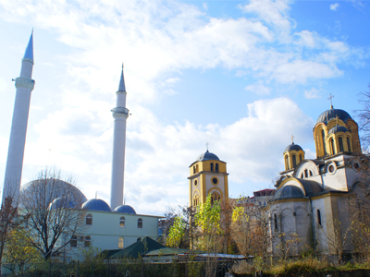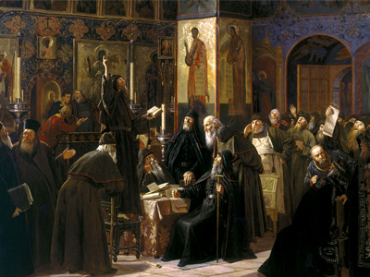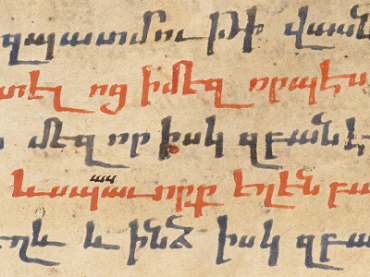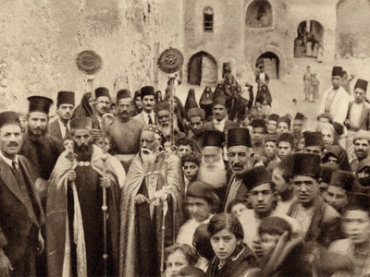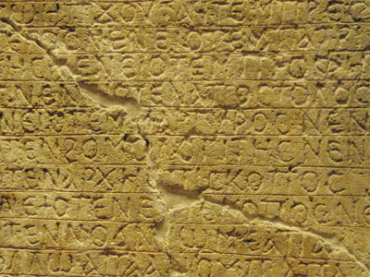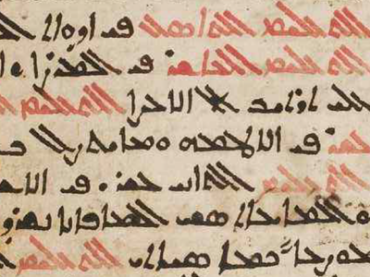Syriac and Eastern Christianity
The Order of the Burial of the Dead
According to the Ancient Rite of the Syrian Orthodox Church of Antioch
Translated by Murad Barsom; Edited by Mor Athanasius Yeshue Samuel
Series: Syriac Liturgies for Worship 6
ISBN: 978-1-61143-960-1
A bilingual edition (Syriac and English) of the service of burial as used by the Syriac Orthodox Church today.
$165.00
M’ade’dono The Book of the Church Festivals
According to the Ancient Rite of the Syrian Orthodox Church of Antioch
Translated by Murad Barsom; Edited by Mor Athanasius Yeshue Samuel
Series: Syriac Liturgies for Worship 7
ISBN: 978-1-61143-961-8
A bilingual edition (Syriac and English) of the church festivals (Christmas, Epiphany, presentation to the temple, Palm Sunday, Maundy Thursday, Good Friday, Easter, Pentecost, etc.) as used by the Syriac Orthodox Church today.
$212.00
Syriac Literature
An English Translation of La Littérature Syriaque
By Rubens Duval
Series: Gorgias Eastern Christian Studies 35
ISBN: 978-1-61143-962-5
Despite having been written over a century ago, the 3rd edition of Rubens Duval's History of Syriac Literature remains one of the best - and most readable - introductions to Syriac literature. This edition provides the first English translation of the work, translated by Olivier Holmey.
$179.00
The East Syriac Psalm Headings
A Critical Edition
By HF Van Rooy
Series: Texts and Studies (Third Series) 8
ISBN: 978-1-61143-867-3
The Psalm Headings remain one of the most difficult and puzzling pieces of the Hebrew Bible. The present study looks at how these titles were treated in the East Syriac traditions. This volume gives a history of research and presents a new critical edition based on previously unpublished manuscripts. The Psalm headings in the East Syriac tradition reflect the exegesis of the Antiochene school, especially Diodore of Tarsus and Theodore of Mopsuestia. The headings contain a summary of Theodore's exegesis which had an important influence on the work of Syriac interpreters such as Ishodad of Merv and Bar Hebraeus.
$154.00
Hugoye - Journal of Syriac Studies (index)
Volumes 1–10
Edited by J. Edward Walters & Logan Wilmoth
Series: Gorgias Handbooks 22
ISBN: 978-1-4632-0078-7
This publication is an index to Hugoye: Journal of Syriac Studies, Volumes 1–10. It includes indices organized by volume contents, article titles, authors, books reviewed, and subject keywords.
$33.00
Bar Hebraeus The Ecclesiastical Chronicle
An English Translation
Translated by David Wilmshurst
Series: Gorgias Eastern Christian Studies 40
ISBN: 978-1-4632-0535-5
The Ecclesiastical History of Bar Hebraeus is an important source for the history of the Syrian Orthodox Church and the Church of the East. It deserves to be widely read, but has never before been fully translated into English. David Wilmshurst, a noted historian of the Church of the East, has now provided a graceful and accurate English translation of the Ecclesiastical History, with the aim of winning this important text the readership it deserves. Wilmshurst's elegant translation is complemented by a well-informed and helpful introduction, several pages of maps and a comprehensive index of places and persons.
$229.00
Introduction to Syriac Reading and Writing
Series: Gorgias Handbooks 23
ISBN: 978-1-4632-0085-5
This volume introduces the letters of the Syriac alphabet a few at the time, and each set of letters is accompanied by guides to pronunciation and the correct way to write the letters, including helpful charts and illustrations. Practice exercises at the end of each section provide the user with copious opportunities for review to facilitate rapid acquisition. This volume will be helpful to all who want to learn the basics of Syriac pronunciation and orthography without being inundated with technical linguistic jargon. The volume is an extract of Chapter 1 of Kiraz’s The New Syriac Primer.
$31.00
Women in Aphrahat
Some Observations
By Adam Lehto
Series: Analecta Gorgiana 1039
ISBN: 978-1-4632-0087-9
Fourth-century Aphrahat is characterized as misogynist, especially when he compares women to Satan. This may be an unintended result of contemporary Christian literature. The the eschatological context of Aphrahat’s asceticism, salvific role of Mary, victimization in Aphrahat’s work, and positive statements about women negotiate this view.
$35.00
A Study in Syriac Historiographical Tradition
Series: Analecta Gorgiana 1040
ISBN: 978-1-4632-0088-6
Syriac tradition remembers sixth century Byzantine emperor Justinian I as the harsh persecutor of the faithful, while his wife Theodora is revered as the “believing queen”, champion and protectress of the dissenting non-Chalcedonian church.
$36.00
The Essential Lightness of Being
Series: Analecta Gorgiana 1041
ISBN: 978-1-4632-0089-3
This is a preliminary study of aspects of the spiritual development of Hindiyya ‘Ajaymi, a Syro-Lebanese religious woman who lived from 1727–98. Highlights include her mystical experiences as well as later compositions for her religious community.
$36.00
Inscriptions Syriaques de Salamas, en Perse
Series: Analecta Gorgiana 1042
ISBN: 978-1-4632-0090-9
This publication presents the transcription and translation of eight Syriac inscriptions from the Persian region of Salamas found in ancient cemeteries and church buildings. The inscriptions are accompanied by brief commentary and helpful introduction.
$36.00
Repentance and Fasting from an Ascetical Perspective
A Comparative Reading of Jacob of Serugh and an Unpublished Shortened Version of a Collection of Homilies by Severus of Antioch
Series: Analecta Gorgiana 1043
ISBN: 978-1-4632-0091-6
Saints Jacob of Serugh and Severus of Antioch provided monastic interpretations for Syriac Orthodoxy. Bcheiry highlights St. Jacob’s exegesis of Jonah as a spiritual struggle with ascetic appearances. St. Severus address the movement from self-deial to purity in his Lenten homilies.
$37.00
Jacob of Serugh, the Man Behind the Mimre
Series: Analecta Gorgiana 1044
ISBN: 978-1-4632-0092-3
Credited by Dinno as the epitome of Syriac spiritual heritage, Mor Jacob of Serugh interpreted the physical world with the hidden realities of God. A prominent theme in Mor Jacob's mimre is the economy of salvation.
$35.00
Mar Jacob of Serugh on Monks and Monasticism
Readings in his Metrical Homilies ‘On the Singles’
Series: Analecta Gorgiana 1045
ISBN: 978-1-4632-0093-0
Griffith discusses “On the Singles”, mimre by Mar Jacob of Serugh, for their reflections of Syrian monastic development. Following a biography and detailed literary analysis, Griffith examines the broader context of regional monastic literature for Mar Jacob’s possible influences.
$35.00
The Syriac Orthodox Celebration of the Eucharist in Light of Jacob of Serugh’s Mimro 95
By Amir Harrak
Series: Analecta Gorgiana 1046
ISBN: 978-1-4632-0094-7
Jacob of Serugh's “Mimro 95” details the significance of the Eucharist and spiritual benefit for participants. Harrak divides verses of this commentary in order to relate stages of liturgy within the Pre-Anaphoric and Anaphoric services of 6th century Syriac worship.
$36.00
To Whom Did Jacob Preach?
Series: Analecta Gorgiana 1047
ISBN: 978-1-4632-0095-4
The long career of Jacob of Serugh provides insights into Scripture and tradition expected by homilies as well as information about his audience. In this publication, Harvey discusses Jacob of Serugh’s concern for congregations to balance lifestyle and devotional obligations.
$34.00
Jacob of Serugh, Homily on Good Friday and Other Armenian Treasures
First Glances
Series: Analecta Gorgiana 1048
ISBN: 978-1-4632-0096-1
Jacob of Serugh's Armenian version of “Homily on Good Friday” is most likely from the reign of Gregory III Pahlawuni (1113–1166 AD). Mathews provides its transcription, commenting that scholarship is widely unaware of Jacob of Serugh’s existing works in Armenian.
$37.00
Jacob of Serugh and His Influence on John of Dara as Exemplified by the Use of Two Verse-Homilies
Series: Analecta Gorgiana 1049
ISBN: 978-1-4632-0097-8
Some of John of Dara’s 9th century treatises survive in Codex 356 in Mardin, in which Jacob of Serugh is called “Jacob of Batnan”, “Jacob”, and titles of respect. This article describes Jacob’s significant influence, comparing two-verse homilies in detail.
$39.00
Humanity’s Sin in Paradise
Ephrem, Jacob of Sarug, and Narsai in Conversation
Series: Analecta Gorgiana 1050
ISBN: 978-1-4632-0098-5
Van Rompay discusses Jacob of Sarug’s understanding of sin by interweaving a conversation with 4th-century Ephrem’s influence and Jacob's late 5th-century contemporary thinker, Narsai. Critical to this discussion is their assumption of Adam’s created capacities.
$35.00
Jacob of Serugh
A Select Bibliographical Guide
Series: Analecta Gorgiana 1051
ISBN: 978-1-4632-0099-2
Brock provides an indispensable bibliographic resource for Jacob of Serugh scholarship. This guide lists Jacob's mimre by biblical passage and liturgical events, uplifted saints and topics, other works including prose and letters, and recommended secondary sources for further study.
$36.00
Ephrem the Syrian's Hymns on the Unleavened Bread
Translation and Introduction by J. Edward Walters
Series: Texts from Christian Late Antiquity 30
ISBN: 978-1-4632-0159-3
In this set of homilies Ephrem (306-373) invites the reader into a world of symbolic interpretation filled with imagination brimming beneath the surface of word-plays, alliteration, and typological comparisons. These hymns thrust the reader into the middle of a context in which Christians and Jews maintain competing practices of a Passover service to the extent that Ephrem feels the need to distinguish between the symbol and the reality. These homilies are presented in their Syriac original alongside an annotated English translation.
$41.00
Syriac into Armenian
The Translations and their Translators
Series: Analecta Gorgiana 1091
ISBN: 978-1-4632-0139-5
This article describes the historical development of Armenian translations of Syriac literature from the 5th century, Intervening- and Clinician Periods. Significant works and figures are highlighted.
$36.00
The Shorter Syriac-Armenian Glossary in Ms. Yale Syriac 9
Part 1
Series: Analecta Gorgiana 1092
ISBN: 978-1-4632-0140-1
Takahashi and Weitenberg provide the history and linguistic analysis of Ms. Yale Syriac 9. Only three such Syriac-Armenian lexica are known to survive. The glossary is classified as the Western branch of Modern Armenian, attributed to Dialect Group 5.
$34.00
The Syriac Presence in the Armenian Translation of the Bible, with Special Reference to the Book of
By Claude Cox
Series: Analecta Gorgiana 1093
ISBN: 978-1-4632-0141-8
Syriac and Armenian Christians interacted regionally and theologically. This paper investigates whether it is thus a viable proposition to deduce Syriac readings from Armenian biblical translations. Cox concludes on a case-basis because extensive use of a similar source text remains questionable.
$36.00
Literary Interactions between Syriac and Armenian
Series: Analecta Gorgiana 1094
ISBN: 978-1-4632-0142-5
Thomson surveyed Syriac literary influence on Armenian Christianity from the time of early missionary activity to the middle ages. Evidence suggests that Armenian Christians are greatly indebted to Syriac contributions on sainthood and theology, but less so for historical writing.
$34.00
Filter by
Filter by price
Filter by manufacturer

